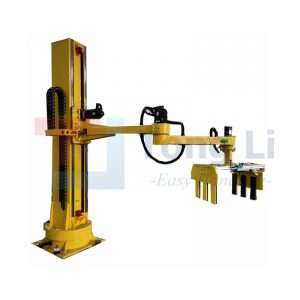A solution to de-palletize is an automated or semi-automated system designed to unload goods from a pallet in a systematic and efficient way. This process, known as de-palletizing, is the reverse of palletizing and is crucial for receiving goods in warehouses, distribution centers, and manufacturing facilities.
The most common and effective solution is a robotic de-palletizing system.
How It Works
A robotic de-palletizer combines several key technologies to handle the complex task of unloading a pallet, especially when products are stacked in non-uniform or interlocking patterns.
Pallet Infeed: The full pallet is delivered to the de-palletizing station, often by an Automated Guided Vehicle (AGV) or a conveyor.
Vision System: The robot’s “eyes” are a crucial component. A 3D vision system, typically a camera or laser scanner, scans the pallet to create a real-time, three-dimensional map of the stacked products. This allows the robot to identify the size, shape, and exact location of each item on the top layer.
Robotic Arm: A multi-axis robotic arm, often with six axes of movement, is the primary mover. The robot’s control software uses the data from the vision system to calculate the optimal path and angle for the arm to approach each item.
End-of-Arm Tooling (EOAT): The robot’s “hand” is a specialized tool designed to securely grip the product.
Vacuum Grippers: Most commonly used for boxes and other flat-surfaced items. They can have a single large suction pad or an array of smaller ones to handle different box sizes.
Mechanical Clamps/Clamps: Used for irregular items, bags, or items that cannot be held with vacuum.
Product Outfeed: Once an item is picked, the robot places it on a conveyor belt, which transports it to the next stage, such as sorting, labeling, or storage. The process is repeated until the entire pallet is unloaded.
Advantages
Improved Ergonomics and Safety: De-palletizing is a physically demanding task that can lead to musculoskeletal injuries. Automating it removes the risk of human injury from repetitive lifting.
Increased Efficiency and Throughput: A robot can work continuously and at a faster, more consistent speed than human workers, significantly increasing the volume of goods processed per hour.
Enhanced Inventory Management: By integrating with a Warehouse Management System (WMS), the robotic system can scan each item as it is removed from the pallet, providing real-time data on incoming inventory.
Flexibility: Modern de-palletizing systems, especially those with advanced vision and AI, can handle a wide variety of product sizes, weights, and stacking patterns. This is a major improvement over older systems that could only handle uniform loads.
